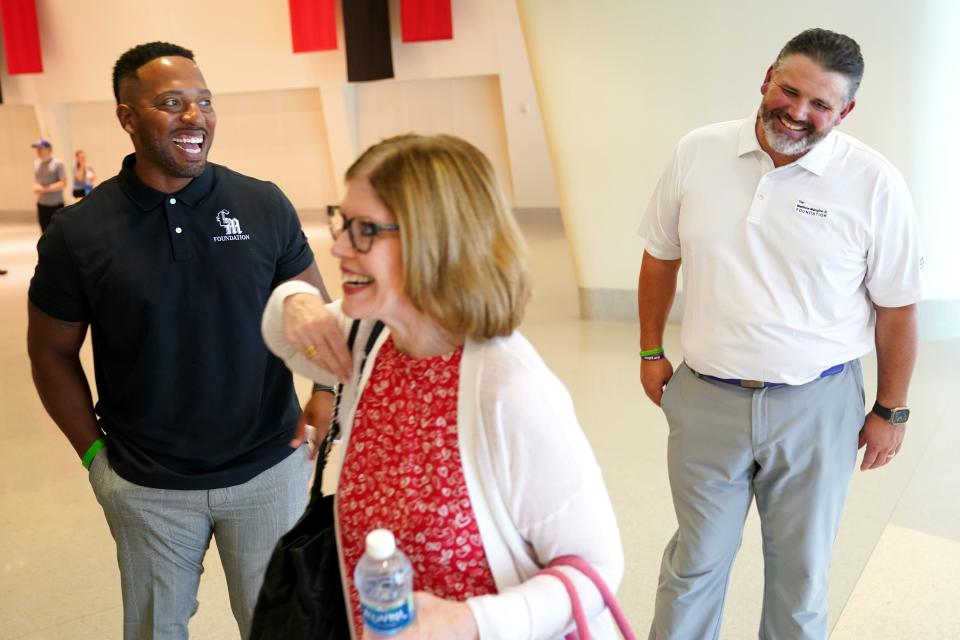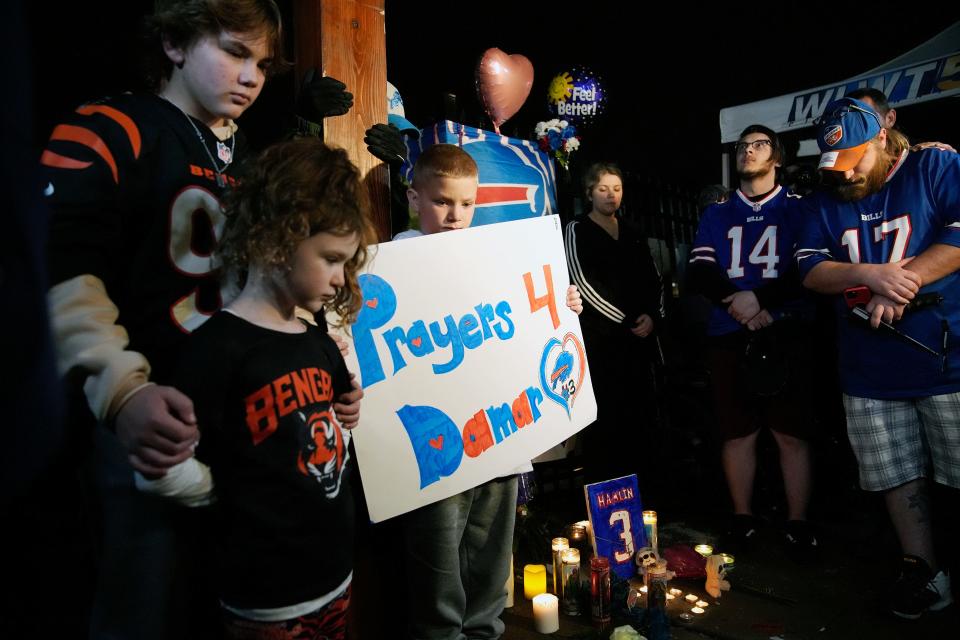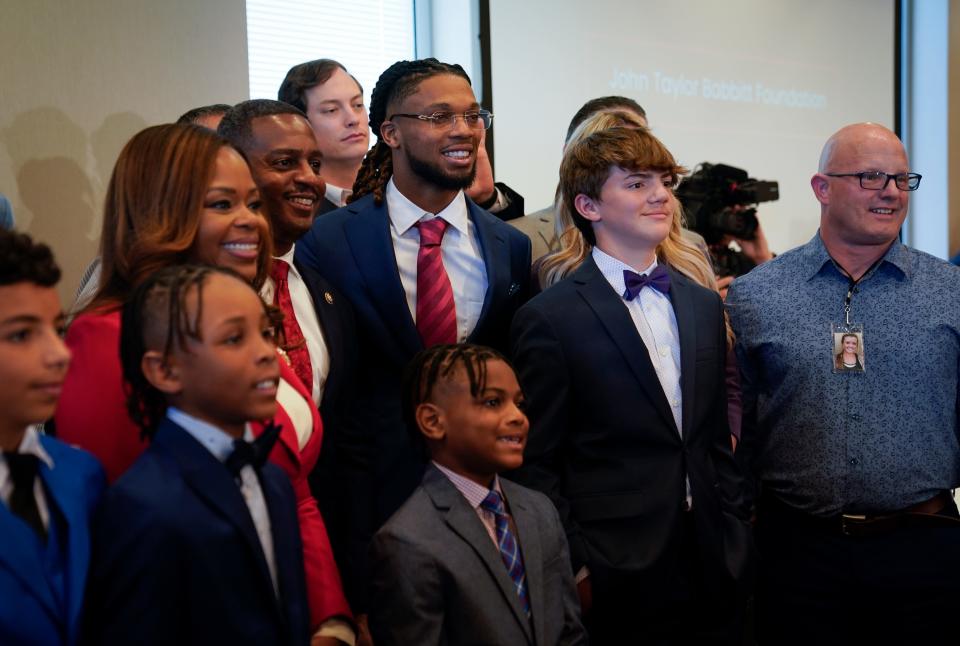Year since Damar Hamlin: Heart Association wants defibrillators as common as extinguishers

PHILADELPHIA − 2023 was the year of sudden cardiac arrest.
Or, as many who study health and safety refer to it, the year of Damar Hamlin … and Bronny James.
The NFL safety and University of Southern California basketball player (and son of NBA star LeBron James) both suffered cardiac arrest through completely different circumstances − and survived.
For decades, medical experts and scientists have tried to shine a light on how to save the life of a person in cardiac arrest by using a defibrillator.
But the bright lights of an NFL stadium just might be the key.

An automated external defibrillator, or AED, is a medical device that can restart a heart by delivering a shock.
Too often, AEDs aren't available in the case of emergency, aren't recognized by the public, or are simply misunderstood.
It was on Jan. 2, 2023 − one year ago Tuesday − that millions of people, globally, saw the resuscitating powers of a portable AED. Many, for the first time.
Hamlin's on-field, Monday Night Football collapse was the quickest national public education update on AEDs since the clichéd scenes of TV medical dramas, depicting doctors rushing in with defibrillation paddles while someone shouts, "Clear!"
Now that the public’s attention is on defibrillators, the American Heart Association wants to make AEDs as recognizable and prolific as another life-saving device − the fire extinguisher.
One hundred cardiac arrest thought leaders − from the U.S., Canada, Ireland, the Netherlands, Spain and Australia − gathered in a Philadelphia hotel conference room in November, just days before the American Heart Association’s Science Symposium, known as the Super Bowl of Science.
The group included physicians, social scientists, AED manufacturers, government officials and more, but they were all there to help guide the association on AED priorities for the next decade.
The association planned to use the discussion to help update its 1995 AED paper, which is considered the industry standard but was called "outdated" by many in the room.
"We have a really, a very valuable moment in time when the national consciousness has turned to (cardiac arrest)," said Dr. Keith Marill, an expert in emergency medicine with Massachusetts General Hospital. "It’s an opportunity."
How the fire extinguisher became so commonplace
A fire started in the basement of Our Lady of the Angels school in Chicago on a cold December day in 1956.
The fire burned unnoticed for at least 28 minutes, according to the University of Illinois’ library archive of the event. The heat broke windows and blasted up the school's wooden stairs. Smoke blew past the first floor's fire doors to the unprotected second floor, where heat and smoke trapped teachers and children in their classrooms.
Ninety-five perished.
It is the largest school fire tragedy in U.S. history. And it brought widespread change.
"(The National Fire Protection Association) credits the lessons learned from the Our Lady of the Angels School Fire with saving the lives of countless children," the university's archive states, "noting that no school fire since 1958 has killed more than 10 people."
Today, fire extinguishers are required to be installed throughout all educational buildings. There are no exceptions.
Their placement and number are based on factors like size and layout of the facility. They must be selected, installed, tested and maintained under National Fire Protection Association requirements.

There are no such requirements for AEDs. Nobody knows how many AEDs are readily accessible in communities across the United States.
"The idea is that the fire extinguisher is inspected and certified on a regular basis," Marill said. "I, as a physician in my hospital, get trained on fire-extinguisher use every year. Trained, and tested, I might add.
"And so, the question is, can you say the same for an AED? No. But you probably should. And that’s where we need to go. The question is, 'how to get there?'"
Does the future of AEDs lie in fire extinguisher’s past?
The Good Samaritan Law is the main federal law concerning AEDs. It encourages people to use CPR or an AED to save a life by giving them legal protection for their efforts.
Much of the symposium's discussion focused on the lack of bystander response in the U.S., compared to countries like Denmark, which celebrates Start a Heart Day each year and developed a nation of volunteer citizen responders. Denmark also has a national AED registry and regularly runs AED ad campaigns.
As a result, Denmark's bystander defibrillation response has increased steadily since the registry's 2011 nationwide launch, allowing emergency dispatchers to connect bystanders to the nearest AED.
"Defibrillation is a critical link in the chain of survival," said Luke Ralston, a biomechanical engineer in the Digital Health Center for the U.S. Food and Drug Administration. "The FDA thinks it is the critical link."
The FDA oversees the manufacturing compliance of Class 3 medical devices, the highest class in the U.S., which means a high regulatory burden for AED manufacturers.
AEDs were invented in the late 1800s. It wasn’t until the 1960s, though, that the device was made portable to be used in ambulances.
By comparison, the modern fire extinguisher was invented in the early 1800s.
In 1997, the accepted fire extinguisher color became signal red, a standard that began in Europe and spread to the U.S.
There are no such national or global requirements for AEDs or their signage.
"If you have seen one AED, then you have seen one AED," Paul Snobelen, from Ontario, Canada, told the group. To learn how to enhance survival rates, Snobelen has interviewed thousands of bystanders who have performed CPR or used an AED.
During the symposium, he presented photos of different AEDs. Some had a lid or a handle or came in a zippered pouch. Many depicted a heart with a lightning bolt, but not all.
The opportunity for manufacturers and regulators, the group agreed, lies in the consistency of design.
"Keep it transparent, keep it simple, keep it accessible," Snobelen said.
The best technology can't replace human response

But Katie Dainty, a qualitative social scientist in Toronto, said the challenge goes beyond accessibility.
"You could put a defibrillator every 2 feet," Dainty told the group. "I think we have a defibrillator problem, but I also think we have a social awareness problem."
On the screen at the front of the ballroom, slides played on a loop, with one showing the smiling faces of cardiac arrest survivors and their families. It included Hamlin standing near a boy in a purple bow tie.
That boy was Joseph Mangine. He lost his older brother, Matthew Mangine Jr., a northern Kentucky soccer player who collapsed during practice in June 2020. Despite having five AEDs on campus, none of Mangine’s coaches knew where the closest AED was located or ran to get one.
Special Report: The Courier Journal spent several months investigating sudden death in high school sports. Here's what we found.
The photo was from March − Hamlin's first public appearance since his collapse. It came during the announcement of the Access to AEDs Act, a federal law that would require, among many things, AEDs in schools.
The slide included the words: “In honor of Matthew Mangine Jr. and the thousands of student athletes who experienced sudden cardiac arrest without an AED.”
The image faded to black.
Just beyond the conference room door, a fire extinguisher hung on the wall.
The closest AED was 26 floors below.
Stephanie Kuzydym is an enterprise and investigative sports reporter, with a focus on the health and safety of athletes. She can be reached at skuzydym@courier-journal.com. Follow her for updates at @stephkuzy.
This article originally appeared on Louisville Courier Journal: Year since Damar Hamlin: American Heart Association wants AEDs common

 Yahoo Sport
Yahoo Sport 






































